“Punk-rock” monkey and handbags made from recycled trash inspire conservation in Colombia
An Interview with Rosamira Guillen of Fundación Proyecto Tití
“Punk-rock” monkey and handbags made from recycled trash inspire conservation in Colombia
Rhett A. Butler, mongabay.com
September 25, 2008
|
|
A small, but charismatic primate has become the symbol for conservation efforts in an area of threatened forest in northwestern Colombia, says a conservationist who helped pioneer a successful community development program that turns trash into attractive handbags.
Rosamira Guillen, Executive Director of the Fundación Proyecto Tití, is working with local communities to protect the endangered Cotton-top tamarin and its tropical dry forest habitat in northwestern Colombia. The effort relies heavily on creating alternative livelihoods for local people who would otherwise collect the squirrel-sized primate for the pet trade or raze its habitat for agriculture. In the process, Fundación Proyecto Tití has created a thriving business that converts plastic bags — a source or mortality among cotton-top tamarins — into fashionable "eco-mochilas" that are now sent all over the world.
"More than 1.5 million plastic bags have been recycled into products that have provided a stable income for communities near our field site," she told mongabay.com in a September 2008 interview with mongabay.com. "Having a stable income allows families to get involved in conservation programs that protect cotton-top tamarins."
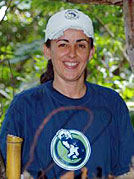
Rosamira Guillen |
The species — which is endemic to Colombia and is well-known for its shock of white hair — is highly sought in the pet trade in Colombia and was once heavily exported for use in biomedicial research for its tendency to spontaneously develop colonic adenocarcinoma. These factors, combined with a 98 percent decline in the extent of its habitat, have reduced the number of wild Cotton-top tamarin to less than 6,000. Still Guillen is hopeful that forest conservation, community development efforts, and local education initiatives could save the species from extinction in the wild.
Fundación Proyecto Tití is supported in part by the Wildlife Conservation Network (WCN), an innovative group that uses a venture capital model to protect some of the world's most endangered species. WCN will be hosting Guillen at its upcoming Wildlife Conservation Expo in San Francisco, California on October 4th. Expo attendees will be able to meet Guillen and learn more about Fundación Proyecto Tití firsthand. The event, which is open to the public and costs $25-50 per person, also features 16 other conservationists working to protect wildlife around the world.
Mongabay: What is your background and how did you get interested in working on the Cotton-top tamarin?
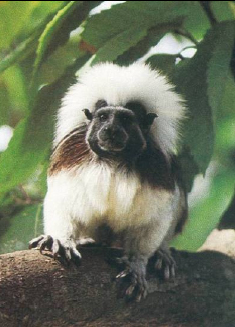
Cotton-top tamarin (Saguinus oedipus). © Fundación Proyecto Tití |
Rosamira Guillen:
I started my professional career as an architect in Barranquilla (Colombia) where I was born and raised. The environment had always been my passion, so I decided to I obtain a Masters Degree in Landscape Architecture to combine architecture with nature. I was later hired to design and implement the Remodeling Master Plan for the Barranquilla Zoo, and that's how I ended up getting involved with wildlife conservation, especially of our native species. While working at the Zoo I obtained an additional degree on Environmental Management.
I later became the director of the Zoo, and that's when I learned about Proyecto Tití, and cotton-top tamarins. I was really amazed to learn that cotton-tops were endemic from our region, and that they were so endangered. So we decided to do something about it and offer our help from the Zoo.
A collaborative partnership was developed for several years and later on I decided to join Proyecto Tití full time and concentrate my efforts, experience and knowledge on the conservation on this amazing primate species.
Mongabay: Why are Cotton-top tamarins endangered and what are presently the greatest threats to them?
Rosamira Guillen:
Our recent population census results have shown that the wild cotton-top tamarin population has been dramatically reduced to less than 6,000 animals. These arboreal monkeys are restricted to small isolated forest patches that cannot sustain a viable population for the long-term. Given the dramatic loss of more than 98% of the tropical dry forest in northern Colombia during the last 30-40 years and the small numbers of animals remaining in the wild, cotton-top tamarins are now listed as Critically Endangered.
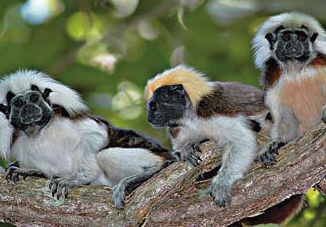
Cotton-top tamarins (Saguinus oedipus). © Fundación Proyecto Tití |
When we examine what factors have caused the population decline there are several reasons: 1) habitat destruction – forests are cut to provide pasture for cattle ranching and areas for agricultural crops that are used to support local populations. Rural communities also cut trees for firewood and building materials; 2) illegal capture for the pet trade – unfortunately the illegal exotic pet trade in Colombia is quite active, and cotton-top tamarins are frequently captured and sold into the local markets as pets and finally 3) lack of understanding – most people don't realize that cotton-top tamarins are found only in Colombia and that they could go extinct in our lifetime unless we educate and inspire people in Colombia to get involved in activities that promote the conservation of forests and these amazing monkeys.
Mongabay: Were large numbers of tamarins collected for medical experiments?
Rosamira Guillen:
Yes, in the late 1960s-early 1970s 20,000-30,000 cotton-top tamarins were exported to the U.S. for use in biomedical research. In 1973 cotton-top tamarins were declared endangered and the massive exportation of animals from Colombia was stopped.
Mongabay: What do you see as the best way to protect Cotton-top tamarins in the wild?
Rosamira Guillen:
We need to protect the remaining forests for cotton-top tamarins and the amazing animals that are found in Colombia. We also need to develop reforestation programs that provide opportunities to connect these small forest fragments into larger, productive areas for wildlife.
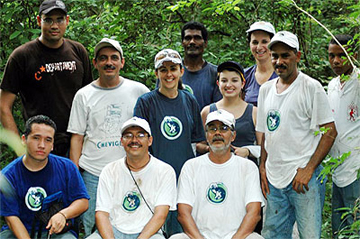
The © Fundación Proyecto Tití team |
We need to educate people about the importance of conserving the cotton-top tamarin and we need to provide opportunities so that people can get involved in activities that directly benefit conservation activities. Our eco-mochila program is a great example of how we have created a sustainable economic project that directly benefits people and tamarins. We've to come up with creative solutions to challenging conservation issues and provide local communities with choices that directly benefit their lives and protect the tamarins.
Our eco-mochila program has turned plastic bag waste into a product that is now sold national and internationally. More than 1.5 million plastic bags have been recycled into products that have provided a stable income for communities near our field site. Having a stable income allows families to get involved in conservation programs that protect cotton-top tamarins and reduce their impact on the natural resources that we are trying to protect in Colombia. Right now, the best way to protect cotton-top tamarins is to protect the forest where live.
Mongabay: Are plastic bags a source of disease transmission from humans to tamarins?
Rosamira Guillen: While we do not have any direct evidence of disease transmission to the tamarins it is quite likely that these plastic bags could harm the tamarins through disease transmission (bacteria) or they might accidentally ingest a piece of the plastic.
Mongabay: Are you looking for donors primarily to provide funds for acquisition of tamarin habitat?
Rosamira Guillen:
We have several priority areas that we need funding. Our top priority is to secure funding to purchase forests that can be established as protected reserves in Colombia. In collaboration with The Nature Conservancy and local Colombian authorities we want to be part of an integrated, multi-organizational plan to protect a significant amount of forest in northern Colombia.
In addition, to protecting habitat our conservation programs can only be successful in local communities become involved. We would like to expand our education programs to include more activities that not only increase knowledge about cotton-top tamarin conservation issues but actively involves the next generation of Colombians in productive activities that will make them future conservation leaders.
Finally, we must continue to develop opportunities for local communities to provide employment and "green" business ventures that compliment our existing programs. While it is important to educate people and protect habitat, we need to ensure that the basic economic needs of people can be met so that they can engage in activities that benefit cotton-top tamarins and the forests we are trying to protect.
Mongabay: You have developed a wonderfully successful project that generates income for communities near critical Cotton-top tamarin habitat. Can you elaborate on the project, how it helps tamarins, and what sparked the idea to create "eco-Mochilas"?
Rosamira Guillen:
Communities living close to the forest are very impoverished and usually depend on forest products to make a living and feed their children. So they go into the forest and cut trees to sell the wood, or capture wild animals for the illegal pet trade.
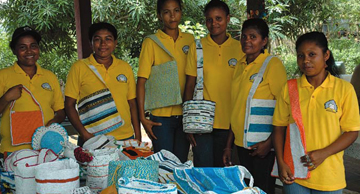
Six of the founding members of ASOARTESANAS proudly display their colorful eco-mochilas, © WCN |
By providing these communities an alternative income which covers the basic necessities for themselves and their families, we are protecting cotton-tops and the forests where they live, along with many other native species.
Eco-mochilas have given these communities the opportunity to generate a sustainable income for over 4 years, while at the same time they recycle plastic bags that litter the environment generating health risks for humans and also for wildlife. They can work from home, on a flexible schedule which allows the women to perform their family duties while producing eco-mochilas. These women are great community and family leaders … they have involved everyone in various stages of making eco-mochilas from collecting plastic bags, cutting them into strips and yes, even getting some help with crocheting!
One day as we were waiting for the rain to stop so that we could go out and watch monkeys, we started looking for something to pass the time. The wife of one of our biologist was with us and she had a crochet hook but no material to crochet. So we started looking at what we had available in our office… we tried cassette tape, rope, but then we came upon a plastic bag. We tore the bag into strips and she was able to crochet with plastic! That's when the idea hit … let's get rid of all this plastic waste and turn it into something that would help wildlife.
Mongabay: When you run out of plastic bags is there another source of raw material for the mochilas?
Rosamira Guillen:
While it is a great thought that we may run out of plastic bags, that doesn't appear to be the case in Colombia. We have a steady supply of plastic that comes to us from both rural and urban communities. Colombia's population and consumerism continues to increase and that means more plastic making its way into the environment.
Mongabay: Colombia is famous for its biodiversity. Is there potential for tourism to raise money for communities and promote the importance of Cotton-top tamarins?
Rosamira Guillen:
Eco tourism is definitely an option and something that we hope will create an awareness about the importance of conserving the cotton-top tamarins and the tropical forests of northern Colombia. Cotton-top tamarins are our flagship species for conservation in northern Colombia. By protecting cotton-top tamarins and their forests you are conserving Colombia's rich biodiversity as well!
Mongabay: Besides buying eco-Mochilas, how else can people in places like the U.S. help Cotton-top tamarin conservation?
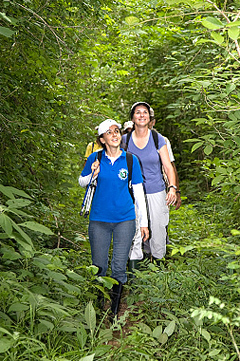
Rosamira Guillen and Proyecto Tití colleagues |
Rosamira Guillen: You can help by telling people about cotton-top tamarins and the need to conserve this critically endangered species. Many people in the US have never seen a cotton-top tamarin. This is a great opportunity to learn something new and get involved! You can support our conservation program by donating to Proyecto Tití. You can visit www.proyectotiti.com to learn more about our conservation initiatives and get involved with saving cotton-tops.
Mongabay: Do you have any tips for aspiring field conservationists?
Rosamira Guillen:
I do. Be passionate about you do. Set your goals and work hard to accomplish them. Look for someone who has a great job or is working on an interesting project – contact them, get to know what they did to get to where they are today. Be curious and interested in learning! You never know where this will lead you! Who would have ever thought that an architect would be leading one of Colombia's most important conservation programs!
Related
Group takes “venture capital” approach to conservation

|
(09/16/2008) An innovative group is using a venture capital model to save some of the world’s most endangered species, while at the same time working to ensure that local communities benefit from conservation efforts. The Wildlife Conservation Network (WCN), an organization based in Los Altos, California, works to protect threatened species by focusing on what it terms “conservation entrepreneurs” — people who are passionate about saving wildlife and have creative ideas for dong so. After a rigorous review process to identify and select projects that will have the greatest impact on conservation in developing countries, WCN provides the conservationist with fund-raising and back-office support, technology, and access to its network of people and resources.